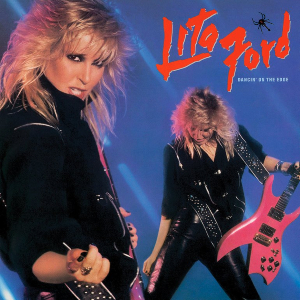Top Qs
Timeline
Chat
Perspective
Dancin' on the Edge
1984 studio album by Lita Ford From Wikipedia, the free encyclopedia
Remove ads
Dancin' on the Edge is second solo studio album by American rock musician Lita Ford. It was her final release with Mercury Records, as she departed to sign with RCA Records in 1987. The album was a moderate commercial success, reaching No. 66 of the US Billboard 200 chart.[3] The album was also nominated for a Grammy Award in category of Best Female Rock Vocal Performance.[4]
Remove ads
Overview
Ford's second solo release after leaving The Runaways in 1979, Dancin' on the Edge features the debut of her new backing band, featuring drummer Randy Castillo, who would soon join Ozzy Osbourne's band, and bassist Hugh McDonald, who later joined Bon Jovi (McDonald had previously played with Jon Bon Jovi in the All Star Revue; the group that recorded the hit "Runaway.") Dancin' on the Edge surpassed the success of Ford's debut album Out For Blood in both sales and airplay.
Music videos for the singles "Gotta Let Go" and "Dressed to Kill" received heavy rotation on MTV during the summer of 1984. "Gotta Let Go" was a minor hit in England, reaching #94 on the UK Singles Chart. The music video for "Dressed to Kill" featured a cameo from Ford's then-fiancée, Tony Iommi of Black Sabbath. Ford toured relentlessly in support of the album for most of 1984, culminating in a pre-Headbangers Ball concert special recorded for MTV.
Remove ads
Track listing
All songs were written by Lita Ford, except where noted.
- Side one
- "Gotta Let Go" (Ford, Geoffrey Leib) – 4:39
- "Dancin' on the Edge" – 5:00
- "Dressed to Kill" – 3:44
- "Hit 'n Run" (Leib, Moon Calhoun) – 3:54
- Side two
- "Lady Killer" – 3:41
- "Still Waitin'" – 4:20
- "Fire in My Heart" – 3:46
- "Don't Let Me Down Tonight" – 4:42
- "Run with the $" – 4:21
Personnel
- Band members
- Additional musicians
- Geoff Leib - synthesizer, backing vocals
- Robbie Kondor, Aldo Nova - synthesizer
- Production
- Lance Quinn - producer
- Larry Alexander - engineer, mixing
- Malcolm Pollack, Obie O'Brien, Phil Nicole, Gary King - engineers
- Bob Ludwig - mastering at Masterdisk, New York
- Barry Levine - photography
Charts
References
Wikiwand - on
Seamless Wikipedia browsing. On steroids.
Remove ads

